Analysis of the Influence of Forests on Landslides in the Bijie Area of Guizhou
Abstract
:1. Introduction
2. Materials and Methods
2.1. Study Area
2.2. Data Sources
2.2.1. Geological Condition
2.2.2. Forestry Change Data
2.2.3. Landslide Susceptibility Mapping
2.3. Methods
2.3.1. Contribution Evaluation Model
2.3.2. Spatial Pattern Analysis
3. Results
3.1. Influence of Woodland Types on Landslide Susceptibility
3.2. Forest Origin and Landslide Susceptibility
3.3. Forest Age Group and Landslide Susceptibility
3.4. Dominant Tree Species and Landslide Susceptibility
3.4.1. Dominant Tree Species and Landslide Susceptibility in Qixingguan District
3.4.2. Dominant Tree Species and Landslide Susceptibility in Dafang County
3.4.3. Dominant Tree Species and Landslide Susceptibility in Qianxi County
3.4.4. Dominant Tree Species and Landslide Susceptibility in Jinsha County
3.4.5. Dominant Tree Species and Landslide Susceptibility in Zhijin County
3.4.6. Dominant Tree Species and Landslide Susceptibility in Nayong County
3.4.7. Dominant Tree Species and Landslide Susceptibility in Hezhang County
3.4.8. Dominant Tree Species and Landslide Susceptibility in Weining County
4. Discussion
4.1. Forest Types
4.2. Forest Origin
4.3. Forest Age
4.4. Dominant Tree Species
4.5. Forest Management Strategy
5. Conclusions
Author Contributions
Funding
Institutional Review Board Statement
Informed Consent Statement
Data Availability Statement
Acknowledgments
Conflicts of Interest
References
- Li, Z.; Zhang, F.; Gu, W.; Dong, M.L. The Niushou landslide in Nanjing City, Jiangsu Province of China: A slow-moving landslide triggered by rainfall. Landslides 2020, 17, 2603–2617. [Google Scholar] [CrossRef]
- Stanley, T.; Kirschbaum, D.B. A heuristic approach to global landslide susceptibility mapping. Nat. Hazards 2017, 87, 145–164. [Google Scholar] [CrossRef] [PubMed] [Green Version]
- Salvati, P.; Petrucci, O.; Rossi, M.; Bianchi, C.; Pasqua, A.A.; Guzzetti, F. Gender, age and circumstances analysis of flood and landslide fatalities in Italy. Total Environ. 2018, 610–611, 867–879. [Google Scholar] [CrossRef] [PubMed]
- Hu, X.S.; Brierley, G.; Zhu, H.L.; Li, G.R.; Fu, J.T.; Mao, X.Q.; Yu, Q.Q.; Qiao, N. An exploratory analysis of vegetation strategies to reduce shallow landslide activity on loess hillslopes, Northeast Qinghai-Tibet Plateau, China. J. Mt. Sci. 2013, 10, 668–686. [Google Scholar] [CrossRef] [Green Version]
- China Government Network. National Geological Disasters in 2021 [EB/OL](2022-01-12) (2022-01-13). Available online: http://www.mnr.gov.cn//dt/ywbb/202201/t20220113_2717375.html (accessed on 13 January 2022).
- Ghestem, M.; Sidle, R.C.; Stokes, A. The influence of plant root systems on subsurface flow. Implications for slope stability. Bioscience 2011, 61, 86961. [Google Scholar] [CrossRef]
- Depicker, A.; Jacobs, L.; Mboga, N.; Smets, B.; Rompaey, A.V.; Lennert, M.; Wolff, E.; Kervyn, F.; Michellier, C.; Dewitte, O.; et al. Historical dynamics of landslide risk from population and forest-cover changes in the Kivu Rift. Nat. Sustain. 2021, 4, 965–974. [Google Scholar] [CrossRef]
- Grima, N.; Edwards, D.; Edwards, F.; Petley, D.; Fisher, B. Landslides in the Andes: Forests can provide cost-effective landslide regulation services. Sci. Total Environ. 2020, 745, 141128. [Google Scholar] [CrossRef]
- Kim, H.G.; Park, C.Y. Landslide susceptibility analysis of photovoltaic power stations in Gangwon-do, Republic of Korea. Geomat. Nat. Hazards Risk 2021, 12, 2328–2351. [Google Scholar] [CrossRef]
- Schmaltz, E.M.; Steger, S.; Glade, T. The influence of forest cover on landslide occurrence explored with spatio-temporal information. Geomorphology 2017, 290, 250–264. [Google Scholar] [CrossRef]
- Griffiths, J.W.; Lukens, C.E.; May, R. Increased forest cover and limits on clear-felling could substantially reduce landslide occurrence in Tasman, New Zealand. N. Z. J. For. Sci. 2020, 50. [Google Scholar] [CrossRef]
- Hwang, T.; Kangw, S.; Kim, J.; Kim, Y.; Lee, D.; Band, L. Evaluating drought effect on MODIS Gross Primary Production (GPP) with an eco-hydrological model in the mountainous forest, East Asia. Glob. Chang. Biol. 2008, 14, 1037–1056. [Google Scholar] [CrossRef]
- Dorren, L.; Schwarz, M. Quantifying the Stabilizing Effect of Forests on Shallow Landslide-Prone Slopes. In Ecosystem-Based Disaster Risk Reduction and Adaptation in Practice; Springer: Berlin/Heidelberg, Germany, 2016; pp. 255–270. [Google Scholar]
- Huang, G.; Zheng, M.; Peng, J. Effect of Vegetation Roots on the Threshold of Slope Instability Induced by Rainfall and Runoff. Geofluids 2021, 2021, 6682113. [Google Scholar] [CrossRef]
- Li, P.; Xiao, X.; Wu, L.; Li, X.; Zhang, H.; Zhou, J. Study on the Shear Strength of Root-Soil Composite and Root Reinforcement Mechanism. Forests 2022, 13, 898. [Google Scholar] [CrossRef]
- Peduzzi, P. Landslides and vegetation cover in the 2005 North Pakistan earthquake: A GIS and statistical quantitative approach. Nat. Hazards Earth Syst. Sci. 2010, 10, 623–640. [Google Scholar] [CrossRef]
- Jamal, M.; Mandal, S. Monitoring forest dynamics and landslide susceptibility in Mechi–Balason interfluves of Darjiling Himalaya, West Bengal using forest canopy density model (FCDM) and Landslide Susceptibility Index model (LSIM). Model. Earth Syst. Environ. 2016, 2, 1–17. [Google Scholar] [CrossRef] [Green Version]
- Davoudi, M.H.; Aghda, S.M.F.; Pour, G.R.S.A. Landslide stabilization by tree root reinforcement. WIT Trans. Ecol. Environ. 2004, 75, 39–45. [Google Scholar]
- Dias, A.S.; Pirone, M.; Urciuoli, G. Review on the methods for evaluation of root reinforcement in shallow landslides. In Advancing Culture of Living with Landslides, Vol 2: Advances in Landslide Science; Springer: Berlin/Heidelberg, Germany, 2017; pp. 641–648. [Google Scholar]
- Moos, C.; Bebi, P.; Graf, F.; Mattli, J.; Rickli, C.; Schwarz, M. How does forest structure affect root reinforcement and susceptibility to shallow landslides? Earth Surf. Process. Landf. 2016, 41, 951–960. [Google Scholar] [CrossRef]
- Kobayashi, Y.; Mori, A.S. The potential role of tree diversity in reducing shallow landslide risk. Environ. Manag. 2017, 59, 807–815. [Google Scholar] [CrossRef]
- Fan, C.C.; Su, C.F. Role of roots in the shear strength of root-reinforced soils with high moisture content. Ecol. Eng. 2008, 33, 157–166. [Google Scholar] [CrossRef]
- Tan, H.; Chen, F.; Chen, J.; Gao, Y.F. Direct shear tests of shear strength of soils reinforced by geomats and plant roots. Geotext. Geomembr. 2019, 47, 780–791. [Google Scholar] [CrossRef]
- Bordoni, M.; Cislaghi, A.; Vercesi, A.; Bischetti, G.B.; Meisina, C. Effects of plant roots on soil shear strength and shallow landslide proneness in an area of northern Italian Apennines. Bull. Eng. Geol. Environ. 2020, 79, 3361–3381. [Google Scholar] [CrossRef]
- Montgomery, D.; Schmidt, K.; Greenberg, H.; Dietrich, W. Forest clearing and regional landsliding. Geology 2000, 28, 311–314. [Google Scholar] [CrossRef]
- Tosi, M. Root tensile strength relationships and their slope stability implications of three shrub species in the Northern Apennines (Italy). Geomorphology 2007, 87, 268–283. [Google Scholar] [CrossRef]
- Facelli, J.M.; Temby, A.M. Multiple effects of shrubs on annual plant communities in arid lands of South Australia. Austral. Ecol. 2002, 27, 422–432. [Google Scholar] [CrossRef]
- Wang, X.; Huang, Z.; Hong, M.M.M.; Zhao, Y.F.; Ou, Y.S.; Zhang, J. A comparison of the effects of natural vegetation regrowth with a plantation scheme on soil structure in a geological hazard-prone region. Eur. J. Soil Sci. 2019, 70, 674–685. [Google Scholar] [CrossRef]
- Zhang, G.P.; Xu, J.; Bi, B.G. Relationship between landslide and debris flow hazards and environmental factors. Chin. J. Appl. Ecol. 2009, 20, 653–658. [Google Scholar]
- Iqbal, J.; Tu, X.; Xu, L. Landslide hazards in reservoir areas: Case study of Xiangjiaba reservoir, Southwest China. Nat. Hazards Rev. 2017, 18, 04017009. [Google Scholar] [CrossRef]
- Yang, D.; Qiu, H.; Zhu, Y.; Liu, Z.; Pei, Y.; Ma, S.; Du, C.; Sun, H.; Liu, Y.; Cao, M. Landslide Characteristics and Evolution: What We Can Learn from Three Adjacent Landslides. Remote Sens. 2021, 13, 4579. [Google Scholar] [CrossRef]
- Hua, F.Y.; Wang, L.; Fisher, B.; Zheng, X.L.; Wang, X.Y.; Yu, D.W.; Tang, Y.; Zhu, J.G.; Wilcove, D.S. Tree plantations displacing native forests: The nature and drivers of apparent forest recovery on former croplands in Southwestern China from 2000 to 2015. Biol. Conserv. 2018, 222, 113–124. [Google Scholar] [CrossRef]
- Wang, Q.; Yang, R. Study on REEs as tracers for late permian coal measures in Bijie City, Guizhou Province, China. J. Rare Earths 2008, 26, 121–126. [Google Scholar] [CrossRef]
- Wang, M.; Zhang, L.; He, Y.; Liu, L.; Chen, D.; Shan, A.; Feng, Y.; Yang, X. Soil fungal communities affect the chemical quality of flue-cured tobacco leaves in Bijie, Southwest China. Sci. Rep. 2022, 12, 2815. [Google Scholar] [CrossRef] [PubMed]
- Li, T. Research on Earthquake Disaster Risk Ssment Model and Its Application in Bijie City, Guizhou Province; Kunming University of Science and Technology: Kunming, China, 2015. [Google Scholar]
- Li, L.; Huang, M.; Liu, Z.J.; Xu, Q.Y.; Tong, X.J.; Lu, P.L. Landslide hazard risk assessment in Bijie area based on RS and GIS. J. Nat. Disasters 2011, 20, 177–182. [Google Scholar]
- Varnes, D.J. Slope movement types and processes. Spec. Rep. 1978, 176, 11–33. [Google Scholar]
- Cruden, D.M.; Varnes, D.J. Landslide types and processes. In Landslides-Investigation and Mitigation; Turner, K.A., Schuster, R.L., Eds.; National Research Council Transportation Research Board, Special Report; National Research Council: Washington, DC, USA, 1996; Volume 247, pp. 36–75. [Google Scholar]
- Xie, X.N.; Li, Y.C.; Liu, Y. Summary Report on Professional Investigation of Hidden Hidden Dangers of High-Level Hidden Geological Hazards in Guizhou Province; Guizhou Provincial Institute of Geological Environment Monitoring: Guiyang, China, 2019. [Google Scholar]
- Yao, K.; Yang, S.; Wu, S.; Tong, B. Landslide Susceptibility Assessment Considering Spatial Agglomeration and Dispersion Characteristics: A Case Study of Bijie City in Guizhou Province, China. ISPRS Int. J. Geo-Inf. 2022, 11, 269. [Google Scholar] [CrossRef]
- Shen, C.Y.; Feng, Z.K.; Xie, C.; Fang, H.R.; Zhao, B.B.; Ou, W.H.; Zhu, Y.; Wang, K.; Li, H.W.; Bai, H.L.; et al. Refinement of Landslide Susceptibility Map Using Persistent Scatterer Interferometry in Areas of Intense Mining Activities in the Karst Region of Southwest China. Remote Sens. 2019, 11, 2821. [Google Scholar] [CrossRef] [Green Version]
- De Baets, S.; Poesen, J.; Reubens, B.; Baerdemaeker, J.D.; Muys, B. Root tensile strength and root distribution of typical Mediterranean plant species and their contribution to soil shear strength. Plant Soil 2008, 305, 207–226. [Google Scholar] [CrossRef]
- Lee, J.T.; Chu, M.Y.; Lin, Y.S.; Kung, K.N.; Lin, W.C.; Lee, M.J. Root traits and biomechanical properties of three tropical pioneer tree species for forest restoration in landslide areas. Forests 2020, 11, 179. [Google Scholar] [CrossRef] [Green Version]
- Yu, K.Y.; Liu, J.; Yang, P.; Yao, X. Research on the relationship between forest management process and regional landslides. J. Cent. South Univ. For. Technol. 2016, 36, 5–10, 16. [Google Scholar]
- Kim, D.; Im, S.; Lee, C.; Woo, C. Modeling the contribution of trees to shallow landslide development in a steep, forested watershed. Ecol. Eng. 2013, 61, 658–668. [Google Scholar] [CrossRef]
- Fusun, S.; Jinniu, W.; Tao, L.; Yan, W.; Haixia, G.; Ning, W. Effects of different types of vegetation recovery on runoff and soil erosion on a Wenchuan earthquake-triggered landslide, China. J. Soil Water Conserv. 2013, 68, 138–145. [Google Scholar] [CrossRef]
- Li, J.; Wang, X.; Jia, H.X.; Liu, Y.; Zhao, Y.F.; Shi, C.M. Assessing the soil moisture effects of planted vegetation on slope stability in shallow landslide-prone areas. Soils Sediments 2021, 21, 2551–2565. [Google Scholar] [CrossRef]
- Phillips, C.; Hales, T.; Smith, H.; Basher, L. Shallow landslides and vegetation at the catchment scale: A perspective. Ecol. Eng. 2021, 173, 106436. [Google Scholar] [CrossRef]
- Šilhán, K. A new tree-ring-based index for the expression of spatial landslide activity and the assessment of landslide hazards. Geomat. Nat. Hazards Risk 2021, 12, 3409–3428. [Google Scholar] [CrossRef]
- Sati, S.P.; Sundiyal, Y.P. Role of some tree species in slope instability. Himal. Geol. 2007, 28, 75–78. [Google Scholar]
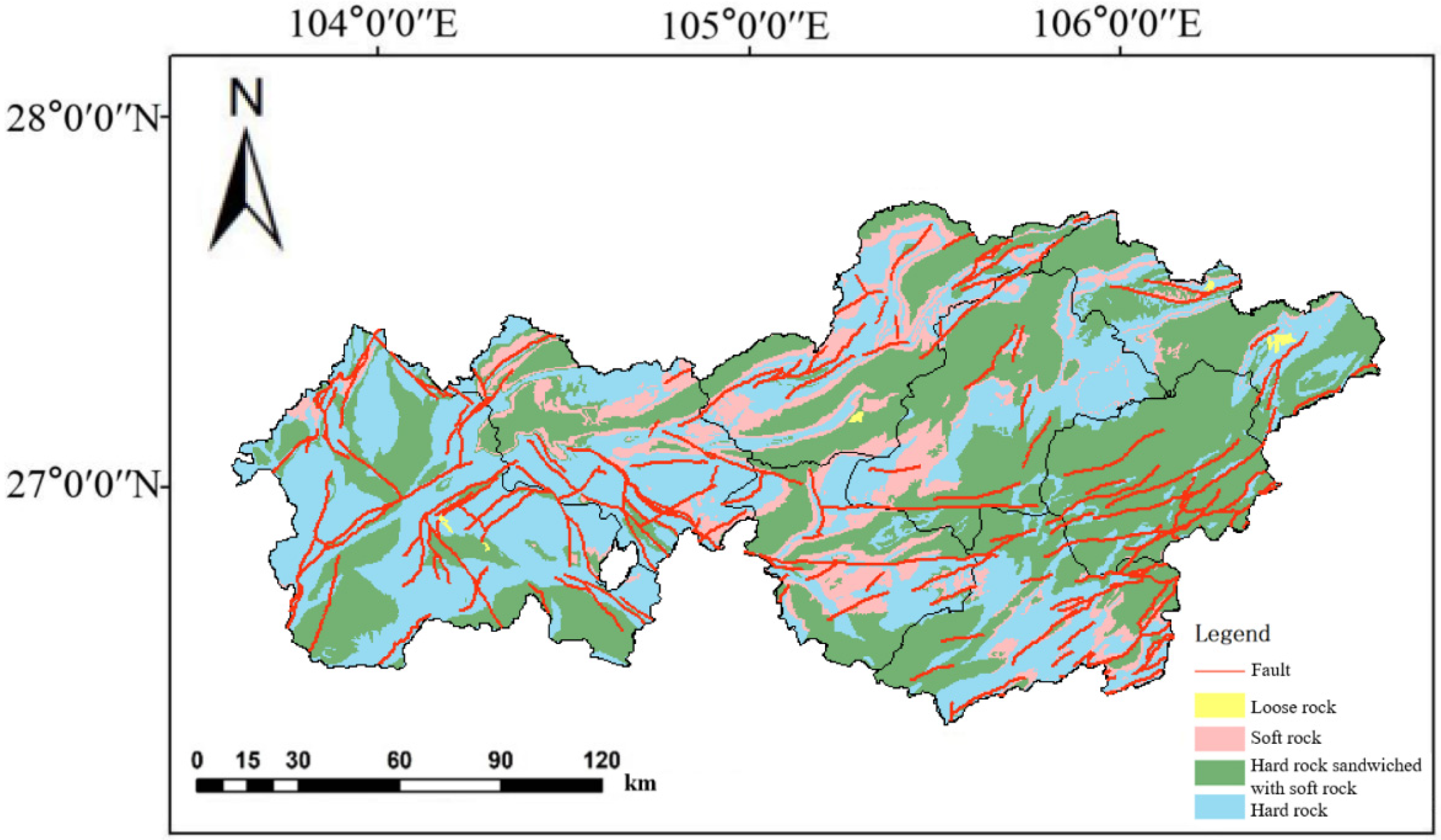

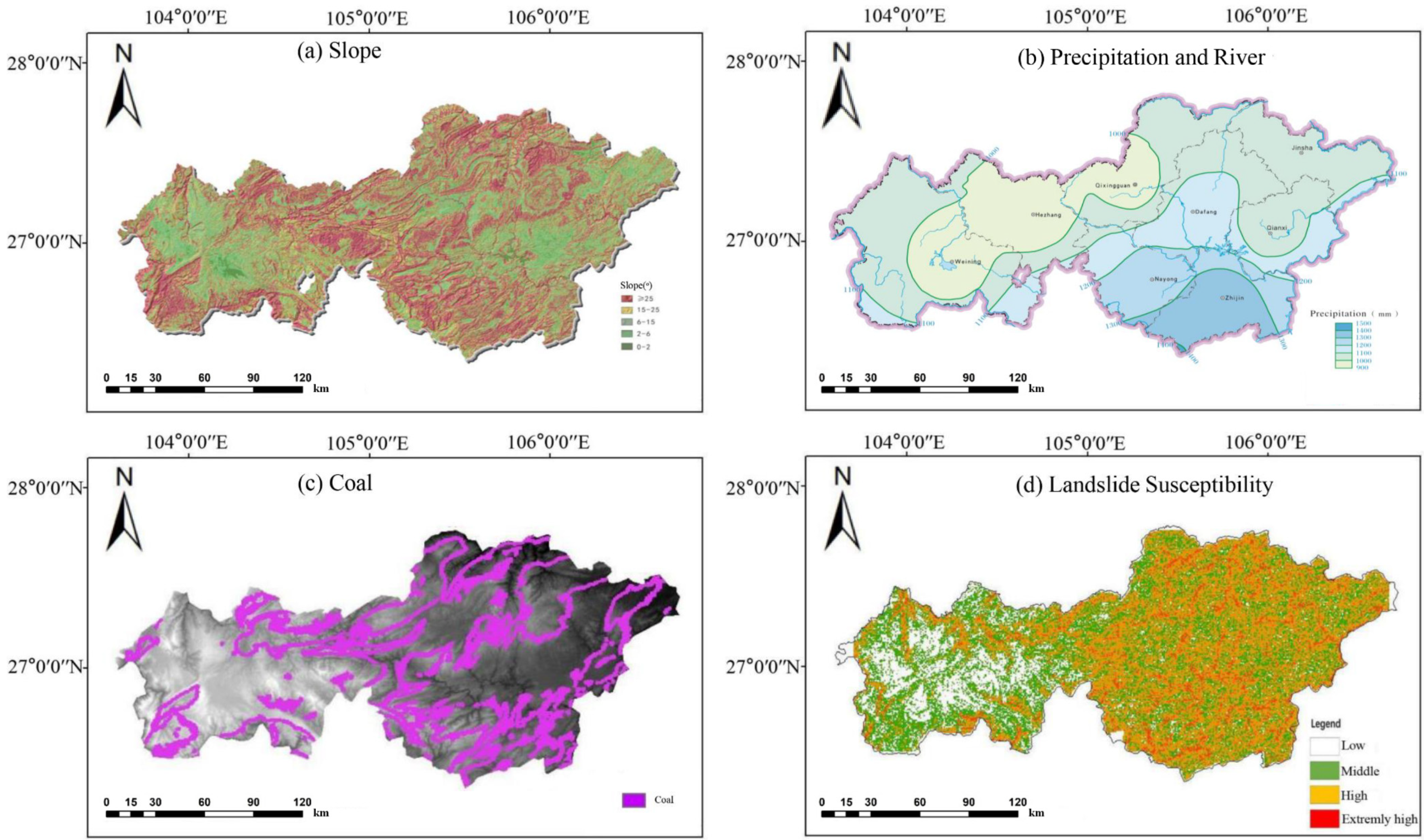


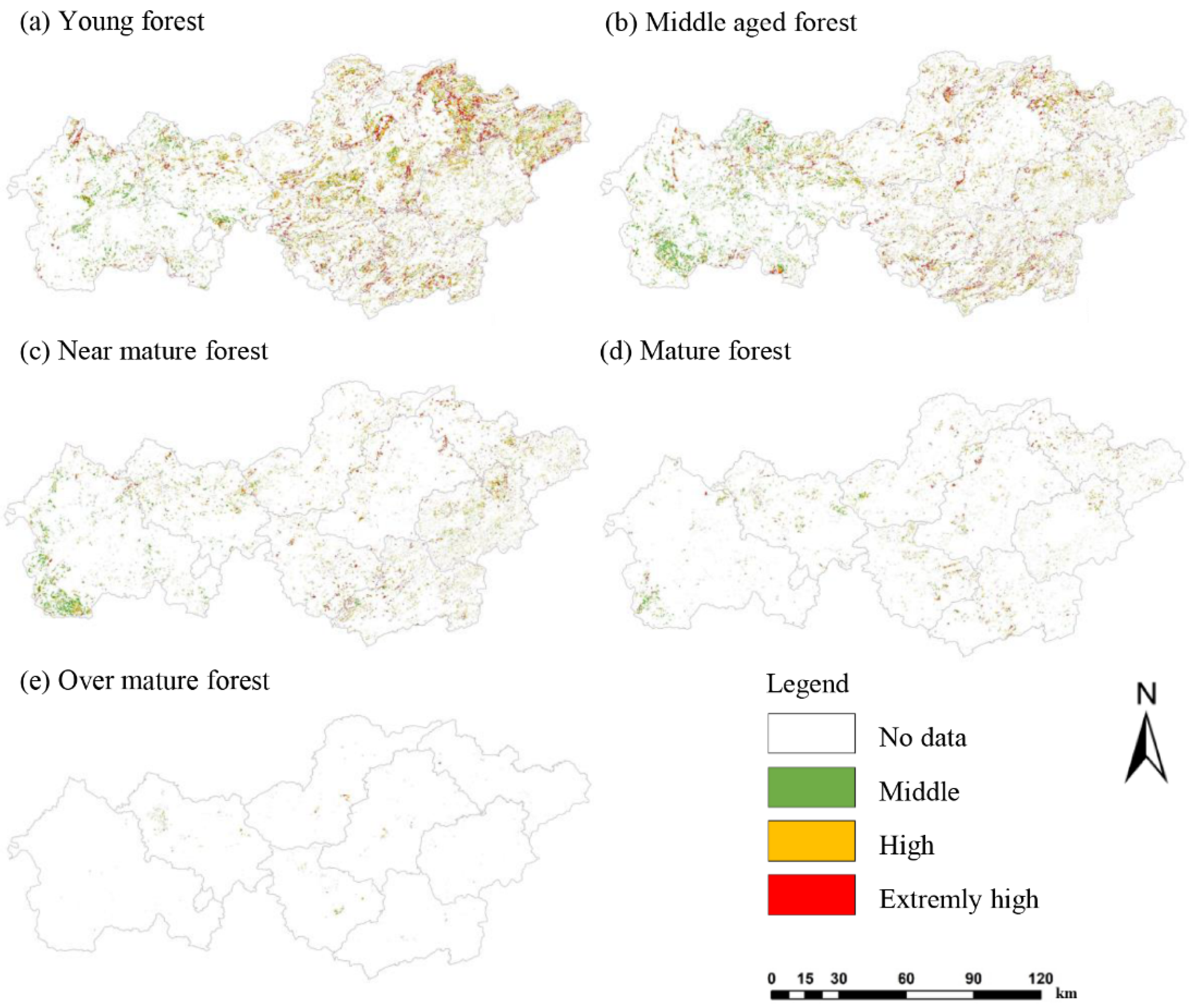
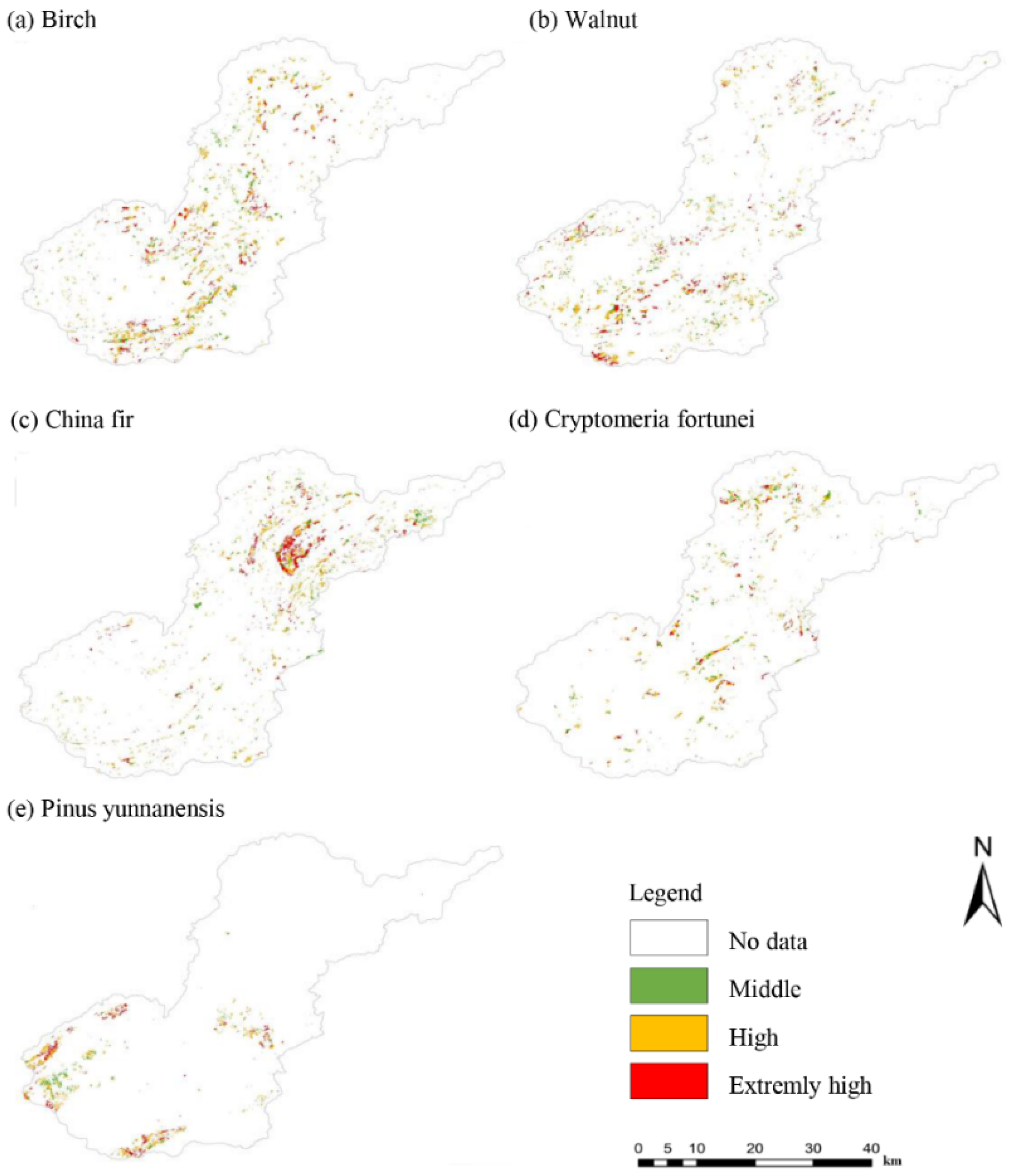
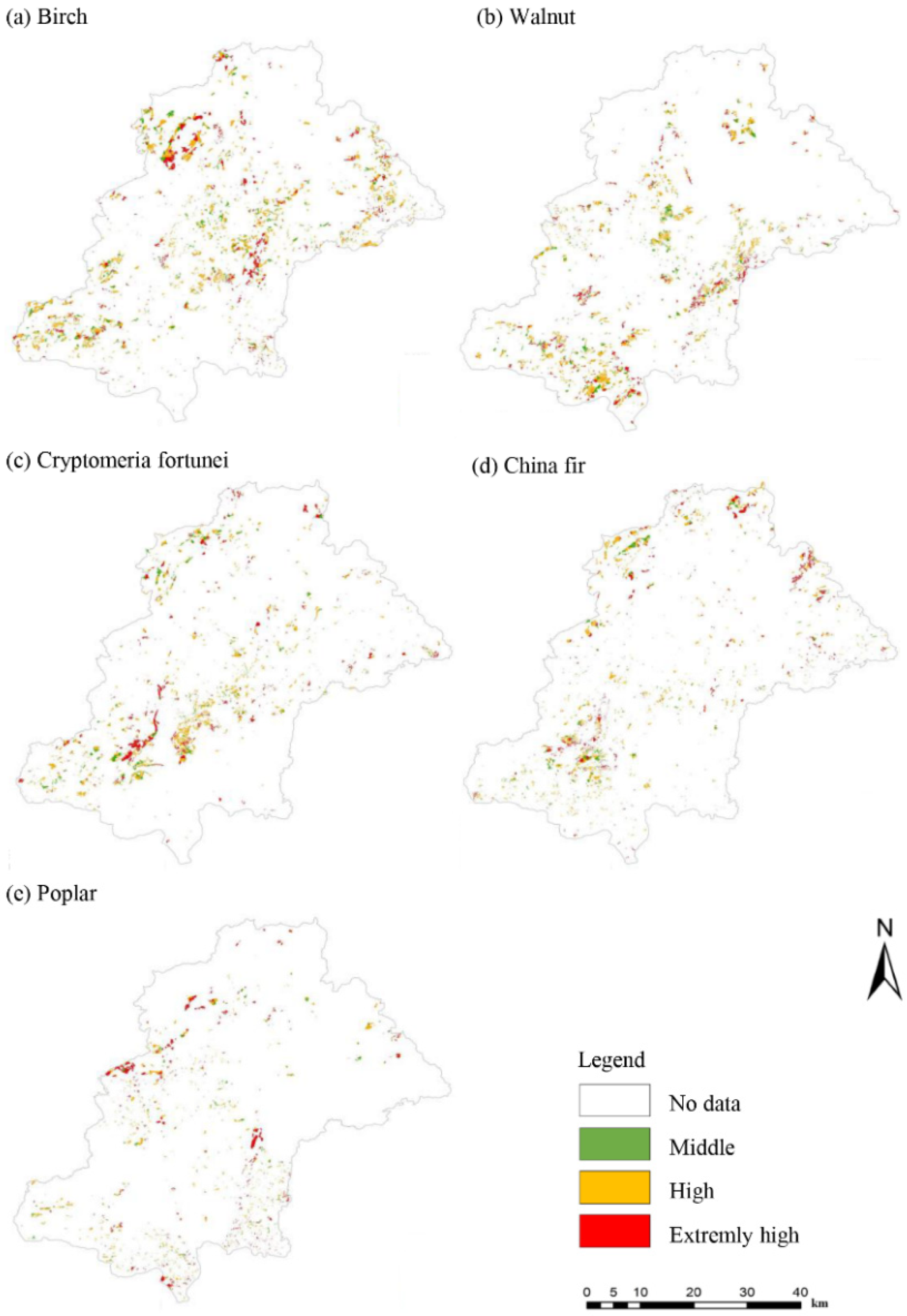

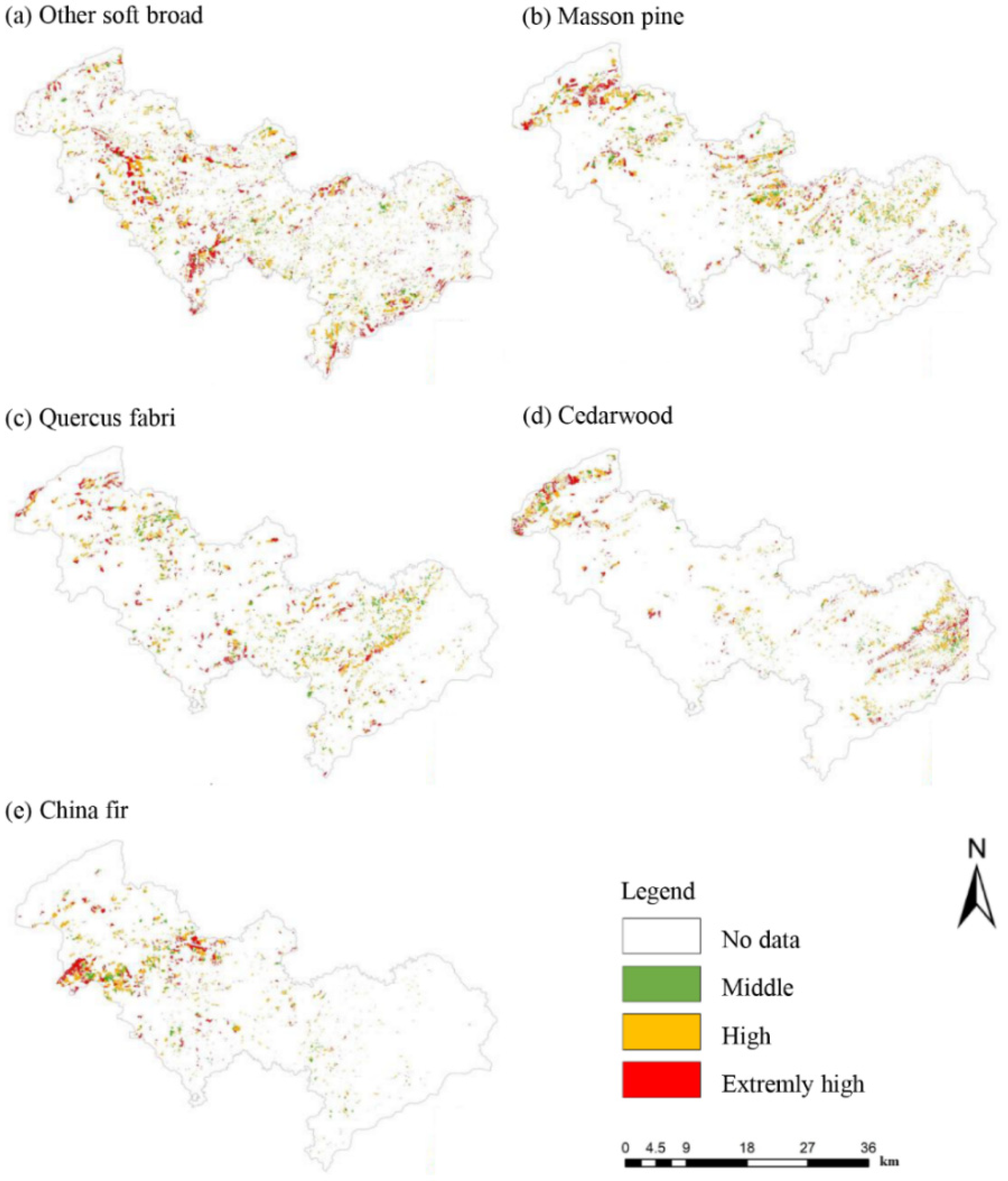

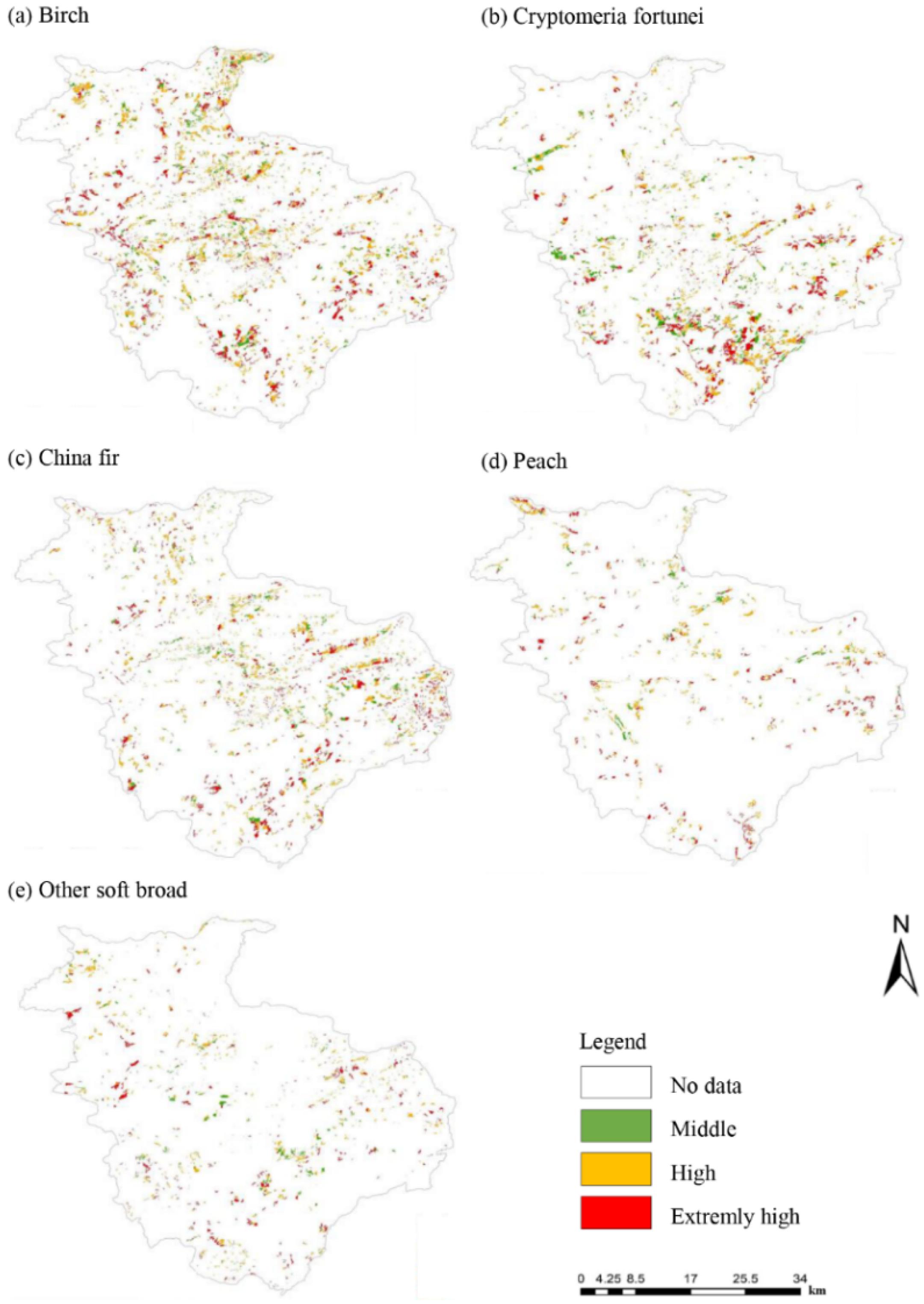
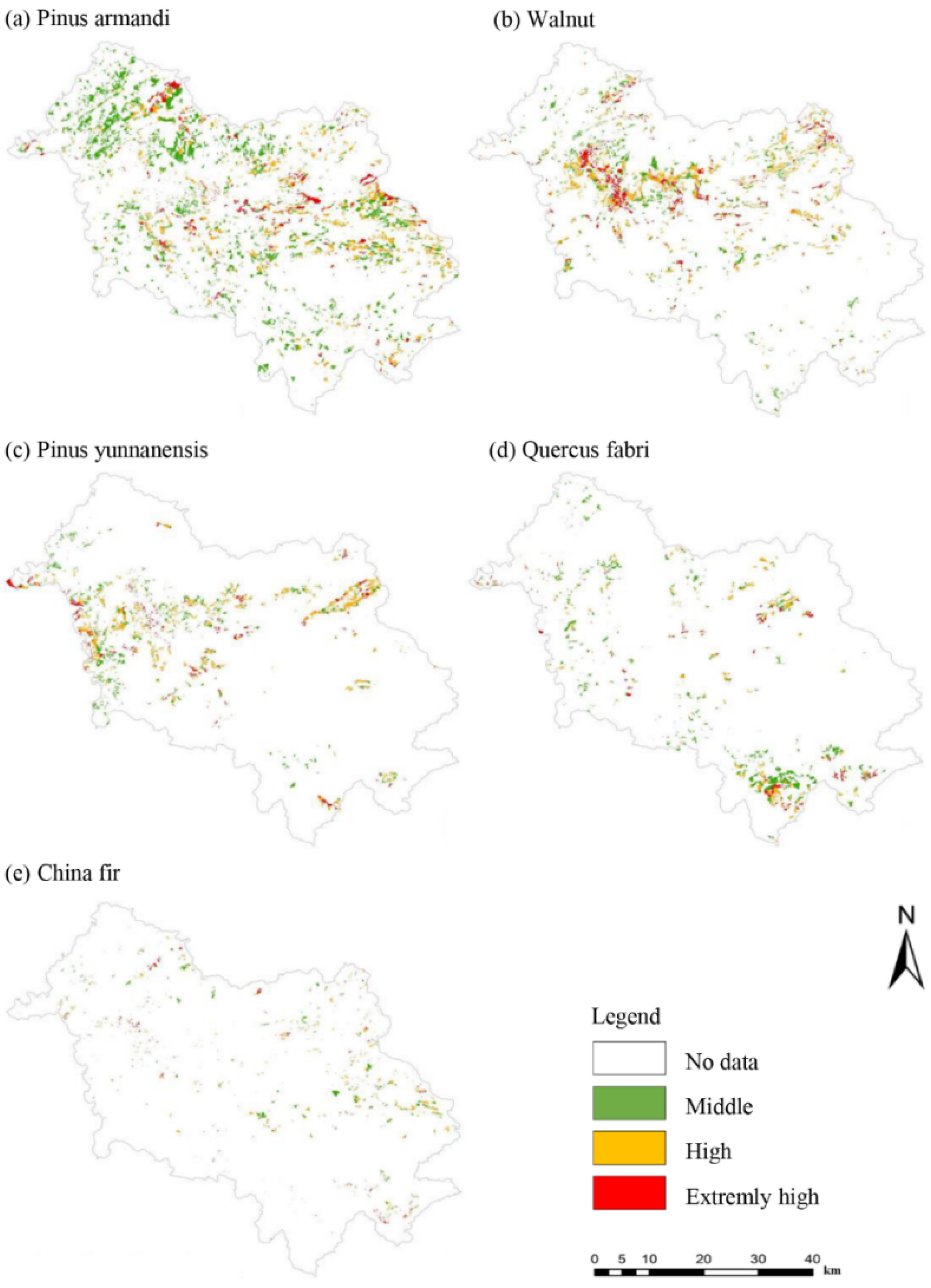

| Forest land Use | Landslide Susceptibility | This Type of Forest | Contribution | ||||||||
|---|---|---|---|---|---|---|---|---|---|---|---|
| Medium | High | Extremely High | Area (hm2) | Ratio (%) | Medium | High | Extremely High | ||||
| Area (hm2) | Ratio (%) | Area (hm2) | Ratio (%) | Area (hm2) | Ratio (%) | ||||||
| Woodland | 195,589 | 52.94 | 297,205 | 56.42 | 221,121 | 60.12 | 770,782 | 55.79 | 0.49 | 0.50 | 0.52 |
| Sparse forest | 122.74 | 0.03 | 129.44 | 0.02 | 87.77 | 0.02 | 372.26 | 0.03 | 0.57 | 0.49 | 0.48 |
| Shrubland | 148,250 | 40.13 | 219,637 | 41.69 | 144,049 | 39.17 | 582,091 | 42.7 | 0.50 | 0.51 | 0.49 |
| Forest Origin | Landslide Susceptibility | This Type of Forest | Contribution | ||||||||
|---|---|---|---|---|---|---|---|---|---|---|---|
| Medium | High | Extremely High | Area (hm2) | Ratio (%) | Medium | High | Extremely High | ||||
| Area (hm2) | Ratio (%) | Area (hm2) | Ratio (%) | Area (hm2) | Ratio (%) | ||||||
| Natural | 221,323 | 61.9 | 323,311 | 57.77 | 215,198 | 59.27 | 864,556 | 59.92 | 0.50 | 0.49 | 0.50 |
| Artificial | 136,210 | 38.1 | 236,364 | 42.23 | 147,899 | 40.73 | 576,821 | 40.08 | 0.49 | 0.52 | 0.51 |
| Age Group | landslide Susceptibility | This Type of Forest | Contribution | ||||||||
|---|---|---|---|---|---|---|---|---|---|---|---|
| Medium | High | Extremely High | Area (hm2) | Ratio (%) | Medium | High | Extremely High | ||||
| Area (hm2) | Ratio (%) | Area (hm2) | Ratio (%) | Area (hm2) | Ratio (%) | ||||||
| Young forest | 73,380 | 37.52 | 142,055 | 47.8 | 89,794 | 47.82 | 334,187 | 43.36 | 0.47 | 0.53 | 0.53 |
| Medium aged forest | 71,280 | 36.45 | 91,323 | 30.73 | 60,353 | 32.14 | 258,411 | 33.53 | 0.52 | 0.48 | 0.49 |
| Near mature forest | 36,896 | 18.86 | 42,438 | 14.28 | 25,115 | 13.38 | 124,144 | 16.11 | 0.54 | 0.47 | 0.46 |
| Mature forest | 13,037 | 6.67 | 19,290 | 6.49 | 11,533 | 6.14 | 49,612 | 6.44 | 0.51 | 0.50 | 0.49 |
| Over mature forest | 992 | 0.51 | 2098 | 0.71 | 966 | 0.51 | 4429 | 0.57 | 0.47 | 0.56 | 0.47 |
| District | Dominant Tree Species | Landslide Susceptibility | This type of Forest | Contribution | ||||||||
|---|---|---|---|---|---|---|---|---|---|---|---|---|
| Medium | High | Extremely High | Area (hm2) | Ratio (%) | Medium | High | Extremely High | |||||
| Area (hm2) | Ratio (%) | Area (hm2) | Ratio (%) | Area (hm2) | Ratio (%) | |||||||
| Qixingguan | Birch | 2611 | 7.52 | 7805 | 9.05 | 3646 | 7.16 | 14,342 | 8.06 | 0.48 | 0.53 | 0.47 |
| Walnut | 2095 | 6.03 | 6114 | 7.09 | 3592 | 7.06 | 12,145 | 6.83 | 0.47 | 0.51 | 0.51 | |
| Chinese fir | 2140 | 6.16 | 5519 | 6.4 | 4171 | 8.2 | 12,140 | 6.83 | 0.48 | 0.49 | 0.55 | |
| Cryptomeria fortunei | 1762 | 5.07 | 4093 | 4.74 | 1810 | 3.56 | 7878 | 4.43 | 0.54 | 0.52 | 0.45 | |
| Pinus yunnanensis | 1003 | 2.89 | 3176 | 3.68 | 1842 | 3.62 | 6194 | 3.48 | 0.46 | 0.52 | 0.51 | |
| Dafang | Birch | 3555 | 10.72 | 10,638 | 10.73 | 5101 | 8.26 | 19,689 | 9.94 | 0.52 | 0.52 | 0.46 |
| Walnut | 2608 | 7.87 | 7494 | 7.56 | 3527 | 5.71 | 13,890 | 7.02 | 0.53 | 0.52 | 0.45 | |
| Cryptomeria fortunei | 2199 | 6.63 | 6039 | 6.09 | 3549 | 5.75 | 12,073 | 6.1 | 0.52 | 0.50 | 0.49 | |
| Chinese fir | 1715 | 5.17 | 5123 | 5.17 | 3059 | 4.95 | 10,029 | 5.07 | 0.51 | 0.51 | 0.49 | |
| Poplar | 955 | 2.88 | 2772 | 2.8 | 2820 | 4.57 | 6710 | 3.39 | 0.46 | 0.46 | 0.59 | |
| Qianxi | Osmanthus | 8245 | 31.67 | 20,993 | 31.1 | 14,409 | 41.13 | 44,568 | 33.89 | 0.48 | 0.48 | 0.55 |
| Masson pine | 3841 | 14.75 | 9147 | 13.55 | 4435 | 12.66 | 17,851 | 13.57 | 0.52 | 0.50 | 0.48 | |
| Other soft broad | 2421 | 9.3 | 6583 | 9.75 | 3240 | 9.25 | 12,528 | 9.53 | 0.50 | 0.51 | 0.49 | |
| Cedarwood | 1892 | 7.27 | 4608 | 6.83 | 2163 | 6.18 | 8888 | 6.76 | 0.52 | 0.50 | 0.48 | |
| Broad-leaved mixed forest | 1827 | 7.02 | 4742 | 7.03 | 1885 | 5.38 | 8634 | 6.57 | 0.52 | 0.52 | 0.46 | |
| Jinsha | Other soft broad | 3305 | 14.53 | 11,153 | 16.45 | 9488 | 20.49 | 24,385 | 17.53 | 0.46 | 0.49 | 0.54 |
| Masson pine | 3287 | 14.45 | 9273 | 13.68 | 5333 | 11.51 | 18,128 | 13.03 | 0.53 | 0.51 | 0.47 | |
| Quercus fabri | 2887 | 12.69 | 7949 | 11.72 | 4359 | 9.41 | 15,522 | 11.16 | 0.54 | 0.51 | 0.46 | |
| Cedarwood | 1623 | 7.14 | 6045 | 8.92 | 4143 | 8.94 | 11,916 | 8.57 | 0.46 | 0.51 | 0.51 | |
| Chinese fir | 1788 | 7.86 | 5501 | 8.11 | 3733 | 8.06 | 11,295 | 8.12 | 0.49 | 0.50 | 0.49 | |
| Zhijin | Cryptomeria fortunei | 3707 | 13.63 | 9778 | 13.6 | 7291 | 12.06 | 21,150 | 12.98 | 0.51 | 0.51 | 0.48 |
| Chinese fir | 2947 | 10.84 | 7506 | 10.44 | 6751 | 11.17 | 17,575 | 10.79 | 0.50 | 0.49 | 0.51 | |
| Birch | 2457 | 9.04 | 6732 | 9.36 | 5130 | 8.48 | 14,636 | 8.98 | 0.50 | 0.51 | 0.49 | |
| Other soft broad | 1785 | 6.56 | 4962 | 6.9 | 4267 | 7.06 | 11,188 | 6.87 | 0.49 | 0.50 | 0.51 | |
| Walnut | 1137 | 4.18 | 3168 | 4.4 | 3186 | 5.27 | 7551 | 4.63 | 0.48 | 0.49 | 0.54 | |
| Nayong | Birch | 2864 | 11.43 | 8991 | 15.79 | 6538 | 13.74 | 18,875 | 13.94 | 0.46 | 0.53 | 0.49 |
| Cryptomeria | 3347 | 13.36 | 6230 | 10.94 | 5762 | 12.11 | 16,206 | 11.97 | 0.53 | 0.48 | 0.51 | |
| Chinese fir | 2014 | 8.04 | 5798 | 10.18 | 4479 | 9.41 | 12,681 | 9.37 | 0.47 | 0.52 | 0.50 | |
| Peach | 1046 | 4.17 | 2910 | 5.11 | 2236 | 4.7 | 6243 | 4.61 | 0.48 | 0.53 | 0.51 | |
| Other soft broad | 1099 | 4.39 | 2460 | 4.32 | 2243 | 4.71 | 6142 | 4.54 | 0.49 | 0.49 | 0.51 | |
| Hezhang | Pinus armandi | 19,016 | 25.89 | 10,475 | 19.6 | 4311 | 18.7 | 45,373 | 22.87 | 0.53 | 0.47 | 0.46 |
| Walnut | 5755 | 7.83 | 8250 | 15.43 | 4172 | 18.1 | 20,247 | 10.2 | 0.44 | 0.63 | 0.68 | |
| Pinus yunnanensis | 3869 | 5.27 | 5721 | 10.7 | 2138 | 9.28 | 14,167 | 7.14 | 0.44 | 0.62 | 0.57 | |
| Quercus fabri | 4626 | 6.3 | 2835 | 5.3 | 1328 | 5.76 | 12,007 | 6.05 | 0.51 | 0.47 | 0.49 | |
| Chinese fir | 1473 | 2.01 | 1605 | 3 | 618 | 2.68 | 4276 | 2.16 | 0.48 | 0.60 | 0.56 | |
| Weining | Pinus yunnanensis | 45,751 | 43.48 | 16,011 | 38.91 | 8142 | 29.14 | 99,533 | 38.55 | 0.53 | 0.50 | 0.44 |
| Pinus armandi | 19,326 | 18.37 | 4694 | 11.41 | 1682 | 6.02 | 48,384 | 18.74 | 0.50 | 0.40 | 0.34 | |
| Sawtooth oak | 3739 | 3.55 | 1418 | 3.45 | 776 | 2.78 | 10,468 | 4.05 | 0.47 | 0.46 | 0.42 | |
| Cyclobalanopsis glauca | 849 | 0.81 | 1258 | 3.06 | 1977 | 7.07 | 4381 | 1.7 | 0.37 | 0.69 | 0.96 | |
| Other soft broad | 1485 | 1.41 | 722 | 1.75 | 509 | 1.82 | 3687 | 1.43 | 0.50 | 0.56 | 0.57 | |
Publisher’s Note: MDPI stays neutral with regard to jurisdictional claims in published maps and institutional affiliations. |
© 2022 by the authors. Licensee MDPI, Basel, Switzerland. This article is an open access article distributed under the terms and conditions of the Creative Commons Attribution (CC BY) license (https://creativecommons.org/licenses/by/4.0/).
Share and Cite
Zhang, Y.; Shen, C.; Zhou, S.; Luo, X. Analysis of the Influence of Forests on Landslides in the Bijie Area of Guizhou. Forests 2022, 13, 1136. https://doi.org/10.3390/f13071136
Zhang Y, Shen C, Zhou S, Luo X. Analysis of the Influence of Forests on Landslides in the Bijie Area of Guizhou. Forests. 2022; 13(7):1136. https://doi.org/10.3390/f13071136
Chicago/Turabian StyleZhang, Yu, Chaoyong Shen, Shaoqi Zhou, and Xuling Luo. 2022. "Analysis of the Influence of Forests on Landslides in the Bijie Area of Guizhou" Forests 13, no. 7: 1136. https://doi.org/10.3390/f13071136
APA StyleZhang, Y., Shen, C., Zhou, S., & Luo, X. (2022). Analysis of the Influence of Forests on Landslides in the Bijie Area of Guizhou. Forests, 13(7), 1136. https://doi.org/10.3390/f13071136





